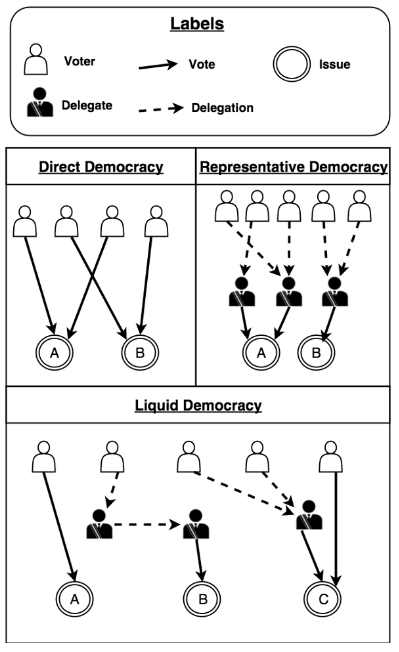WINGS Specification Series #2: Governance systems and decision markets
Forks are popular this year
2016 could be called “The Year of the Forks” of the crypto ecosystem. Every major project has either forked or at least has seriously considered doing so. The forks debates generated lots of noise, deviated both the developers and the early adopters from the original goal of promoting the crypto-currency, and contributed to a negative impression of crypto by the mainstream users.For example, In late 2015 and early 2016 the Bitcoin community spent innumerable energy, time and resources arguing about whether to reverse the block size capacity limit which Satoshi Nakamoto had originally added into the protocol when it became clear that it clearly not enough for the growing transactions volume. Later in 2016, following the hacking of TheDAO contract, the developers of the Ethereum Foundation hard-forked Ethereum to restore TheDAO funds; which lead to dissent parties launching a pre-fork Ethereum chain dubbed Ethereum Classic that has rapidly became popular, creating an uncertainty for the Ethereum community and the adopters.
Efficient governance is the key
These events can be seen as a failure of weak governance systems, that are usually present in the decentralized projects. The lack of methods and tools to quickly and efficiently reach a decision causes an unnecessary spending of resources and introduces a strain on the development team relations.While this happens often in the open-source world, and sometimes leads to a better alternatives emerging (IO.js from Node.js, Jenkins from Hudson etc…), this approach destabilizes and hurts the crypto-currency, which draws its value from participants belief in the immutability of their chosen platform.Some experts have even pointed out that the lack of sophisticated governance and consensus building mechanisms allowing introductions of innovations into an existing block-chain such as Bitcoin, has resulted in a blooming of alt currencies competing for users attention, diluting adoption and negatively influencing the network effect of the original Bitcoin.WINGS aims to solve this by implementing smart contracts that enable decision making mechanisms based on combination of forecast markets technology and liquid democracy. The goal is to enable the WINGS community to quickly and efficiently reach key decisions on the WINGS platform, avoiding the aforementioned pitfalls. Paul Sztorc specifically relates to this capability in his Extra-Predictive Applications of Prediction Markets, noting the forecast “market allows users to sell (“eliminate”) their hard fork discomfort” (pg. 9).
Efficient governance and decision making for institutions
WINGS DAO is not limited to being a social funding platform, but a rather a radically different take on the governance of the institutions that we work at and that we rely on their services in our daily lives. Typical governance structures today rely on centralized and hierarchical models which are old, bureaucratic and inefficient in the global economy (think Uber, Airbnb, Google having to deal with 165 countries’ regulations for a corporate entities). By utilizing the block-chain technology and smart contracts we can do better, thus enabling a leap in productivity and in cross-border operational and transactional costs.Governance and decision-consensus on the WINGS platform are best inspected on two categories: the WINGS platform itself and the project DAOs.
WINGS Platform Governance
WINGS DAO extensively employs forecast markets mechanics in order to enable the WINGS tokens owners to reach agreements on key decisions. A liquid democracy will be initially employed in addition to forecasting, allowing to hedge against decisions made by the majority. However, being a dynamic protocol controlled by the WINGS DAO community, the rules could be changed if the community majority forecasts a benefit resulting from this change. Furthermore, in the future it will be possible to have formal verification that checks whether the proposed high level code changes are in compliance with low level (fundamental, or constitutional) code of a DAO.Thus the result we are aiming is to have the WINGS members engage in a collaborative consensus building process over time to modify the core governance mechanism for the benefit of the WINGS ecosystem users.WINGS DAO is self-determining. It is inspired from philosopher Peter Suber who models a game, Nomic, that is comprised of immutable and mutable rules showing the power of self-amending systems, and logical priority of rule sets (think constitution laws versus statutory laws vs regulations). Furthermore, we propose to use a combination of Futarchy (prediction markets) and Liquid Democracy (fluid delegation of prediction power) for the DAO to make decisions on key issues such as white listing a new DAO, or upgrading the smart contracts of the WINGS platform.
DAO Governance
Project DAOs that launch using WINGS will be able to start with one of the following governance models:
Source: https://medium.com/@DomSchiener/liquid-democracy-true-democracy-for-the-21st-century-7c66f5e53b6f
- Futarchy (forecasting decision markets)
- Liquid Democracy (fluid delegation)
- Direct Democracy (each person decides directly)
Futarchy, conceived by Robin Hanson, is a governance system that uses decision markets based on the predictions of participants. Liquid Democracy (as pictured in the graphic) is a hybrid between the direct and representative democracies, enabling the participants to freely lend and recover the decision power to people they trust to have most knowledge, experience and interest making the best decisions.Over time these governance models could change or evolve into new variations based on the project DAO community voting. Also, new models could be implemented by WINGS via smart contracts update based on community demands.
Conclusion
Considerable thought has been given to the governance mechanisms used on WINGS as we wish to avoid situations that have plagued the crypto projects until now, with governance being an afterthought, namely:
- intended or unintended centralization of control in a developer team
- inability to rapidly adopt innovations that users need
- inefficient tools and methods for token owners to reach a consensus
The WINGS team is reviewing the well-known governance models, and looking at the open source initiatives that would implement or complement it’s WINGS DAO platform vision.
Governance experts are welcome
We are welcoming others who are focused on solving these or similar problems for a collaboration on this fascinating subject of governance. Please contact us via our Telegram, Slack and email (info[AT]wings.ai).
Sources
Buterin, Vitalik. “Daos, Dacs, Das and More: An Incomplete Terminology Guide.” Ethereum Foundation. May 6, 2014. Web. date of Access: August 15, 2016. Available at: https://blog.ethereum.org/2014/05/06/daos-dacs-das-and-more-an-incomplete-terminology-guide/
Davidson, Sinclair and De Filippi, Primavera and Potts, Jason. Disrupting Governance: The New Institutional Economics of Distributed Ledger Technology(July 19, 2016). Date of access: August 15, 2016. Available at SSRN:
Dobson, Nick. BoardRoom: A NextGeneration Decentralized Governance Apparatus. White Paper v0.1. Web. Date of access: August 15, 2016. Available at: http://boardroom.to/BoardRoom_WhitePaper.pdf
Goodman, L.M. Tezos: A Self-Amending Crypto-Ledger Position Paper (August 3, 2014). Web. Date of access: August 15, 2016.Available at:https://tezos.com/pdf/position_paper.pdf
Goodman, L.M. Tezos: A Self-Amending Crypto-Ledger White paper(September 2, 2014). Web. Date of access: August 15, 2016.Available at:https://tezos.com/pdf/white_paper.pdf
Hanson, R. (2013), Shall We Vote on Values, But Bet on Beliefs?. J Polit Philos, 21: 151–178. doi:10.1111/jopp.12008. Accessed on August 15, 2016. Available at: http://mason.gmu.edu/~rhanson/futarchy2013.pdf
Merkle, R. (2016) DAOs, Democracy and Governance. Cryonics Magazine, July - August, Vol 37:4, pp 28–40; Alcor, www.alcor.org. Accessed on August 15, 2016. Available at: http://merkle.com/papers/DAOdemocracyDraft.pdf
Schiener, Dominik. “Liquid Democracy: True Democracy for the 21st Century.” Medium.com. Nov 23, 2015. Web. Date of access: August 15, 2016. Available at https://medium.com/@DomSchiener/liquid-democracy-true-democracy-for-the-21st-century-7c66f5e53b6f
Siegel, David. “E-voting Resources.” Medium.com. March 31, 2016. Web. Date Accessed: August 15, 2016. Available at: https://medium.com/@pullnews/e-voting-resources-510f6fbc6fa5#.rd5sm4mlw
Storcz, Paul. Extra-Predictive Applications of Prediction Markets.Bitcoinhivemind.com. Web. Date of access: August 15, 2016. Available at:http://bitcoinhivemind.com/papers/3_PM_Applications.pdf
Suber, Peter. (1990) The Paradox of Self-Amendment: A Study of Law, Logic, Omnipotence, and Change. Peter Lang Publishing. Web. Accessed on August 15, 2016. Available at:http://legacy.earlham.edu/~peters/writing/nomic.htm
Wright, Aaron and De Filippi, Primavera, Decentralized Blockchain Technology and the Rise of Lex Cryptographia (March 10, 2015). Accessed on August 15, 2016. Available at SSRN: http://ssrn.com/abstract=2580664
Yermack, David, Corporate Governance and Blockchains (November 29, 2015). Accessed on August 15, 2016. Available at SSRN:http://ssrn.com/abstract=2700475


forks aren't more common this year than in previous years.
Most coins if not all are forks of other coins.
You understand it incorrect, in article he means blockchain forks, not fork code of some exists coin.
The point is that it is a major topic this year. It's not about what is common or not, but what is getting mind-share.